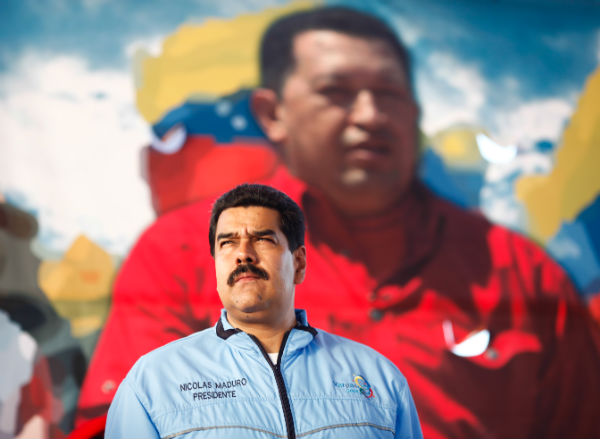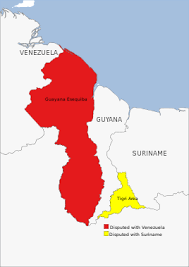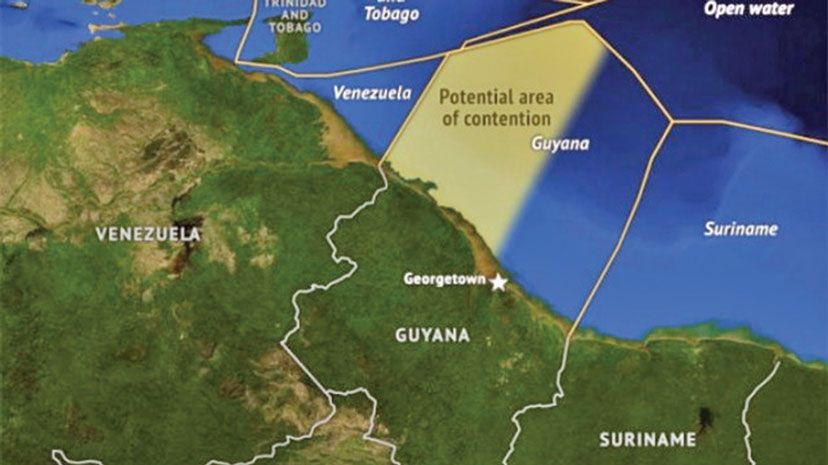Guyana vs Venezuela: South America risks seeing a new military conflict similar to Ukraine

ExxonMobil's string of world-class oil discoveries offshore Guyana, estimated to contain more than 11 billion barrels of oil, has captured the world's attention, but it has also rekindled century-old land disputes thought to have been set by part. In this darling unwanted attention comes from Maduro 's Venezuela. A long and bitter territorial dispute has embroiled the two South American countries, with Caracas claiming nearly 160,000 square kilometers or about three-quarters of Guyana's territory, including the territorial waters containing the Stabroek block, the one identified by Exxon. Guyana rejects this more than 100-year-old claim, with the support of a large part of the international community, but the controversy is growing to such a level as to raise fears that it could have a military evolution, with the dangers that derive from it.
Here is the dispute from the point of view of the terrestrial territories
Here instead is the dispute from the point of view of territorial waters
The hotly contested region, known as Essequibo, includes all of Guyana's lands east of the Essequibo River or nearly three-quarters of the sovereign territory of the former British colony, which was known as British Guiana before independence in 1966. Spain had originally taken control of large parts of Essequibo as part of the colony of the Vice-Reality of New Granada, but the constant contestation of independence movements in Latin America prevented Madrid from consolidating its claims. To define the boundaries of British Guiana, London commissioned the German-born explorer Robert Herman Schomburgk in 1835 to map the western part of the colony and draw a border with Venezuela. Schomburgk's border kicked off the more than a century-old territorial dispute between Venezuela, which had emerged as a sovereign state in 1831 and decided to exercise its colonial legacy after the discovery of gold in Essequibo.
After considerable pressure from the United States, the border between Venezuela and the colony of British Guiana, which became Guyana after independence in 1966, was resolved in 1899 under the Washington Arbitration Treaty. The agreement gave Venezuela control of the lands surrounding the mouth of the Orinoco River, while Britain was given all land west of the Essequibo River. Caracas was extremely dissatisfied with the treaty and, after decades of tension, declared the arbitration treaty null and void in 1962.
Since then, the dispute has seen an ups and downs, with numerous attempts by international bodies to resolve the longstanding dispute. In 1966, the United Nations attempted to find a solution with the signing of the Geneva Protocols, which required Venezuela, the United Kingdom and Guyana to find a peaceful and satisfactory solution to the dispute. At this point the Process of Good Offices was created by the United Nations to mediate Venezuela's territorial claim. After nearly three decades of failing to agree on Guyana and Venezuela, the matter was referred to the International Criminal Court of Justice, or ICJ, in 2018. The court accepted the case but made little progress with Maduro, who ironically faces an IGC investigation for crimes against humanity and refuses to acknowledge the court's jurisdiction. In November 2022, the IGC concluded the preliminary hearing on the objections raised by Venezuela, in which Caracas argued that Guyana's case should be dismissed.
After decades of uncertainty, Caracas' territorial claims against Guyana have intensified after Exxon's discovery of more than 30 world-class oil fields offshore of the Stabroek block. A significant part of this blockade is located in the territorial waters of the region disputed by Venezuela. Exxon's discoveries have uncovered more than 11 billion barrels of recoverable petroleum resources and catapulted Guyana on the path to becoming a major regional producer and exporter of petroleum. At the end of January 2023, Guyana was pumping 393,000 barrels of oil a day, all of which came from the Exxon-operated Stabroek block. This has transformed the former British colony into the sixth largest oil producer in Latin America and the Caribbean, with production expected to exceed one million barrels per day by 2027, making Guyana the third largest oil producer in the region. .
The Stabroek Block oil discoveries have transformed Guyana from an economically backward area into a major global oil producer, propelling the impoverished South American country into the economic stratosphere. Guyana now possesses one of the fastest growing economies in the world: IMF data shows that its 2022 GDP grew by a stunning 57.8% and is projected to grow another 25% in 2023.
Georgetown's oil revenues are increasing in value. According to information provided by the Bank of Guyana, the country's central bank, the former British colony earned $1.4 billion from oil royalties and sales in 2022, more than double the $608 million it received in 2021. The Guyana government and industry analysts expect oil revenues to exceed $1.6 billion in 2023 and rise to more than $7.5 billion by the end of the decade.
As a result, it's easy to understand Maduro's interest in Essequibo at a time when Venezuela's economic crisis has bottomed out and Caracas is desperate to rebuild a shattered oil industry and pump more oil. Among other things, the dispute with the neighboring country allows the Caracas government to distract attention from internal economic and productive problems: in fact, the national oil production company, pa PDSVA, suffocated by lack of investments and old structures, cannot however to increase its oil output. The OPEC member's production has plummeted from a peak of more than three million barrels a day in 1998, before Hugo Chavez became president, to 700,000 barrels a day by February 2023. The catastrophic collapse of Venezuela's oil industry, backbone economic crisis, devastated the economy and triggered a protracted humanitarian catastrophe described as the worst ever to occur outside of war.
PDVSA is unable to significantly increase production volumes or meet the ambitious production targets set by Maduro and his oil minister Tareck El Aissami without a massive capital investment, estimated to be at least $110 billion. This will only happen when Washington has substantially eased sanctions, which is highly unlikely in the foreseeable future. By annexing Essequibo, Caracas will gain access to the region's considerable mineral wealth, including the vast oil resources contained in the offshore block of Stabroek. Over the past decade, there have been frequent incidents of Venezuelan navy vessels harassing navigation in Guyana's territorial waters in the disputed area, including drillships contracted by Exxon. In 2021, two Guyanese fishing vessels were detained for weeks by the Venezuelan navy.
Since 2015, Maduro has vowed on a regular basis to reconquer Essequibo, which is rich in raw materials. Caracas frequently deploys ground forces to the Guyana border and conducts military exercises in the region. In early 2018, the Brazilian military revealed that it had uncovered plans for Venezuela to invade Guyana, which would see Caracas use force to annex Essequibo. Then-Brazilian President Michel Temer pledged to defend Guyana in the event of a Venezuelan invasion, but it is hard to see whether Brasilia could deploy enough forces in a timely manner to repel Venezuela's attack. Brazil and Venezuela share part of the border, but this is a difficult region to reach, with little connection to Brazil's manufacturing heartland. At the same time, however, the Brazilian navy is relatively modern and operationally capable.
If Venezuela launches a military assault to annex Essequibo, Guyana could do little to repel such an event. Venezuela's military outnumbers Guyana's Defense Forces by at least 100 to 1 in terms of manpower, while Caracas possesses modern fighters and naval assets for which Guyana has no valid answer. Maduro's close ties to the Kremlin mean that Venezuela has received extensive military aid from Russia, including modern weapons systems, such as small arms, tanks and fighter-bombers, and training by Russian advisers. While Russia has promised in 2022 that military aid to Venezuela will not be used against Colombia, no similar guarantees have been given regarding Guyana. The consensus is that, without US or Brazilian intervention, a Venezuelan invasion of Essequibo would be successful.
The risk that the border dispute could erupt into conflict is very real. The escalation of tensions between Caracas and Washington over the sanctions and indictments by the US Department of Justice against Maduro and members of his government increase the risk of an outbreak of conflict. Maduro also uses the dispute as a means to distract Venezuelans from the suffering they are enduring as a result of his policies, and the dispute is one of the only points he and the Venezuelan opposition agree on. Putin's invasion of Ukraine, despite international protests, has encouraged authoritarian and illiberal rulers like Maduro to see the application of force as a valid means of achieving their goals. Let's hope we don't see a new conflict that would rekindle old disputes across South America

Thanks to our Telegram channel you can stay updated on the publication of new articles from Economic Scenarios.
The article Guyana vs Venezuela: South America risks seeing a new military conflict similar to Ukraine comes from Scenari Economics .
This is a machine translation of a post published on Scenari Economici at the URL https://scenarieconomici.it/guyana-vs-venezuela-il-sud-america-rischia-di-vedere-un-nuovo-conflitto-militare-simile-allucraina/ on Tue, 28 Mar 2023 09:00:37 +0000.



